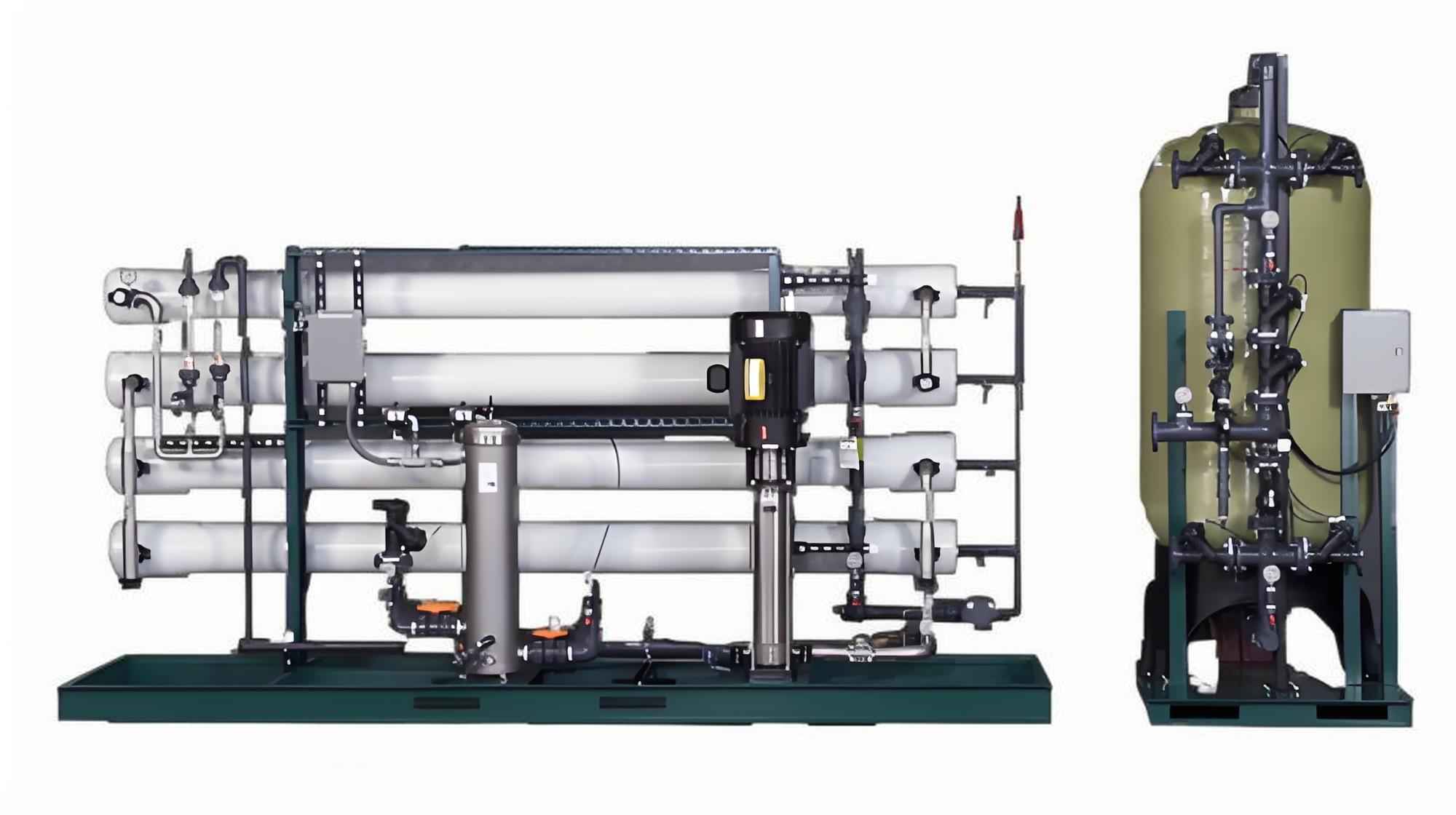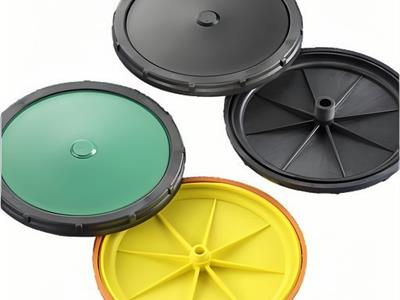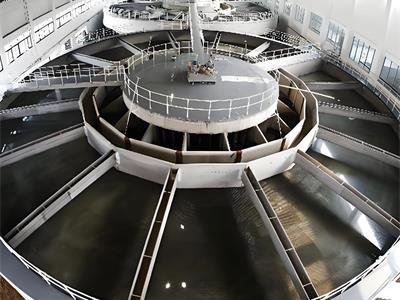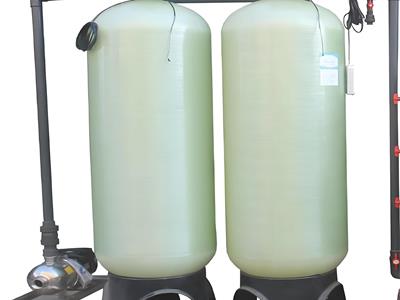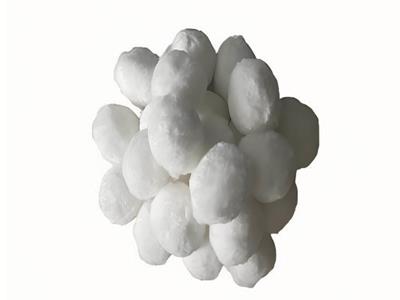- 2025-07-15
Nanofiltration NF
Nanofiltration NF System
The basic principle of nanofiltration membrane technology is to use pressure to separate soluble ions from water through a semi-permeable membrane. Unlike dead-end filters, nanofiltration membranes use different hydraulic characteristics, also known as cross-flow filtration.
Most nanofiltration membranes are composite materials supported by a polymer substrate and use a spiral design instead of a flat or tubular structure. The main model currently used in industrial applications is a spiral structure. To learn more about nanofiltration systems, you need to know the following information.
Similar to reverse osmosis (RO), nanofiltration systems recycle a certain percentage of the incoming water, which is different from ultrafiltration (UF). Most nanofiltration membranes use a spiral wound structure.
FupengWater is a leading global supplier of industrial and commercial nanofiltration systems with more than 20 years of experience in removing impurities from water. Our nanofiltration systems can ensure clean drinking water for any application in the water treatment industry. View our range of nanofiltration systems for commercial sites and plants to meet your water treatment needs.
In water treatment, nanofiltration (NF) is the "bridge" between ultrafiltration membranes and reverse osmosis membranes. It is sometimes referred to as a loose or low rejection RO membrane. Since NF membrane pore sizes range from 0.01 to slightly less than 0.001, it can also be referred to as tight ultrafiltration (UF). In general, NF membrane systems allow more salt to pass through than RO membranes. In addition, NF membrane elements produce the same amount of water as RO water treatment systems at 50% to 70% of the applied pressure.
In some applications, 75% salt rejection is better than 95% to 99% salt rejection, especially when using only half the energy. Unlike RO membrane elements, NF membrane elements from various membrane manufacturers have a wide range of performance. For RO membrane elements, any model with a sodium chloride rejection of less than 99.5% is considered a low-quality product, especially for seawater. For NF membrane elements, any membrane element with a sodium chloride rejection of 40% or more has its place. Nanofiltration is also known as a "softening" membrane because while its salt rejection may be 80% or less, hardness rejection is often well above 90%.
Other applications for nanofiltration include:
Removal of heavy metals from wastewater
Removal of pesticides from groundwater
Laundry wastewater recycling
Water softening
Nitrate removal
What are nanofiltration membranes?
Nanofiltration membranes are used to filter low total dissolved solids (TDS) water to remove organics and soften the water. Nanofiltration technology is used in many water and wastewater treatment industries to effectively remove ions and organics. Nanofiltration technology is also commonly used as a pretreatment for reverse osmosis (RO). In addition to water purification, nanofiltration membranes are also used in the production of food, beverages, and pharmaceuticals.
What is the difference between nanofiltration and reverse osmosis?
While nanofiltration and reverse osmosis systems are similar in design and operational purposes, there are some significant differences between the two. The main difference is that nanofiltration is not as rigorous as reverse osmosis. Nanofiltration operates at lower feed water pressures and does not remove singly charged ions from water as effectively as reverse osmosis membranes.
While reverse osmosis systems can remove up to 99% of chloride and sodium, nanofiltration membranes typically only remove 50% to 80%. This percentage depends on the membrane material type and manufacturing process. However, because nanofiltration is so effective at removing multiply charged ions, it is the preferred method for removing hardness from water without affecting the total dissolved solids content as reverse osmosis does.
Nanofiltration NF application examples:
Application Permeate Concentrate Benefits of NF
Whey/Whey Permeate Saline Wastewater Desalination of whey concentrate Allows recovery of lactose and whey protein concentrate and reduces salt content
Textiles Dyes Water, salt, BOD, COD and color NF is used to desalinate dyes, resulting in higher value products
Alkaline cleaning solutions Alkaline cleaning solutions BOD, COD, suspended solids, alkaline detergents Allows recovery of alkaline cleaning solutions, resulting in lower cleaning chemical costs
Acidic solution recycling Acidic solutions BOD, COD, calcium, suspended solids, acidic water Allows recovery of acidic solutions, resulting in lower cleaning chemical costs
Water Softened water Hard water Drinking water production. Softened water reduces scaling of equipment and heat exchange surfaces.
Antibiotics Saline waste Desalination and concentration of antibiotics NF produces high value pharmaceutical products
FupengWater Nanofiltration System Main Features
1. Continuous water production without regeneration, reducing labor costs.
2. Utilizing more than 98% of the heat source, 98% of organic matter and microorganisms can be removed.
3. Real-time monitoring of conductivity to ensure appropriate water quality.
4. Using a PLC microcontroller, the reverse osmosis membrane is rinsed regularly.
5. It is used to treat industrial wastewater without consuming a large amount of acid and alkali, without secondary pollution, and the operating cost is extremely low.
FupengWater's Nanofiltration Technology
Our system is occasionally used for wastewater recycling because it has a higher flux and lower energy consumption than the reverse osmosis system. Depending on the composition and manufacturing process of the membrane, our nanofiltration system can usually remove 50% to 90% of the wastewater.
It is widely used to remove hardness from water while keeping the total dissolved solids content unchanged because it can effectively remove divalent and trivalent ions. Therefore, it is called a "softening membrane". Our system is often used to remove organic impurities and soften water with a low total dissolved solids content.
FupengWater Nanofiltration System Advantages
Ultraviolet disinfection of permeate water recirculation. Skid-mounted and containerized types are optional. HMI human-machine interface, automatic operation, controlled by PLC. No heating required, energy savings, and reduced noise. Stable operation, high desalination, high recovery, and no pollution.
The ultimate FAQ guide for nanofiltration systems.
Nanofiltration technology was born in the late 1980s, and its popularity has grown exponentially since then. This is mainly due to the sharp shortage of freshwater reservoir resources in recent years. Nanofiltration systems have greatly enhanced the effectiveness of freshwater supplies by effectively treating different feed waters. The following article will take a deep look at all aspects of contemporary nanofiltration systems and their role in water treatment.
➣ What is nanofiltration?
Nanofiltration is a water treatment process that uses membranes and pressure to separate pollutants from influent water. Compared to ultrafiltration and reverse osmosis, nanofiltration uses membranes with smaller pore sizes than ultrafiltration membranes, but slightly larger than reverse osmosis membranes. Nanofiltration is particularly effective in removing divalent ions (calcium and magnesium) from raw water, so it is often used to soften hard water. Unlike ion exchange, nanofiltration does not use sodium or other salts in the water softening/treatment process.
➣ What is a nanofiltration system?
A nanofiltration system is a water treatment device that uses a semi-permeable membrane to separate soluble ions in feed water. Technically, nanofiltration membranes use cross-flow filtration as the primary hydraulic property to treat water. They are primarily used in industrial and commercial applications to treat feed water and improve the quality of tap water.
Nanofiltration devices have a wide range of applications and their treatment capacities vary, with commercial nanofiltration systems treating up to 32,000 gallons per day and industrial-grade nanofiltration systems treating up to 800,000 gallons per day. They are able to produce high-purity product water for a variety of applications.
➣How do nanofiltration systems work?
Some of the basic principles of nanofiltration and reverse osmosis processes are similar. Essentially, both processes rely on perforated membranes and the application of pressure to separate dissolved components in water. However, nanofiltration systems can remove unwanted contaminants without applying as much pressure between dissolved components as reverse osmosis systems do. Typical nanofiltration membrane pore sizes are around 0.001 microns, so a large amount of dissolved salts, a large number of viruses, and organic components can be filtered out. The main types of nanofiltration membranes currently in use are as follows:
➣What are the benefits of using a nanofiltration system?
The main advantage of using a nanofiltration system is that it can provide an unlimited supply of high-quality drinking water. Unlike ion exchange units, nanofiltration units can remove calcium and magnesium ions without adding salt to the water, so the resulting drinking water has a lower salt concentration.
In addition, compared with reverse osmosis, nanofiltration systems operate at lower pressures and ultimately consume less energy. Other advantages of using a nanofiltration system include:
➣What are the applications of nanofiltration systems?
Modern nanofiltration systems are used by different industries to achieve different goals. Due to their ability to effectively remove magnesium and calcium ions, nanofiltration systems are often used as water softening systems.
FupengWater manufactures specialized nanofiltration systems with unique functional properties for various applications. Some of the main uses of nanofiltration units are described below.
Softening raw water for domestic, industrial and commercial use.
Pharmaceutical production.
Food and beverages.
Petroleum refining.
Wastewater treatment solutions.
➣What is the price of a typical nanofiltration system?
Nanofiltration systems are priced differently from different manufacturers. Regardless of the price difference, the total purchase price of a nanofiltration system includes the quality of the materials used, the number and size of the nanofiltration membranes used, the capacity of the system, and the productivity. Therefore, potential buyers are advised to contact the manufacturer for an accurate quote. In addition, there are additional costs associated with the installation and use of the nanofiltration system. The first is the installation fee, which includes building the system support structure and assembling the various components. Other operating expenses include power consumption, labor, and system maintenance. For example, a nanofiltration system with a daily processing capacity of 100,000 cubic meters, operating at a pressure of 15 bar and a flow rate of approximately 550 liters per hour, costs approximately 0.214 euros per cubic meter.
➣What factors should be considered when purchasing a nanofiltration system?
Purchasing a nanofiltration system is a delicate process that requires full understanding of the relevant information to avoid purchasing mistakes. As a customer-centric manufacturer, FupengWater provides free technical consultation to help customers make the right purchasing decisions. We have also collected some key considerations that potential buyers should know before investing in a nanofiltration system. The capacity of the system.
We manufacture a range of nanofiltration systems with capacities suitable for both small and large applications. Your daily treated water needs are the main factors that determine your capacity selection. The expected treated water quality. Most importantly, your future nanofiltration system should be able to produce high-quality water suitable for your specific application. The water quality produced by nanofiltration systems varies, and its impurity retention rate can be customized according to specific contaminants.
Type, concentration and composition of feed water.
Seawater, groundwater, brackish water and wastewater all contain different contaminants, so the concentration and composition of the raw water need to be determined first. Based on this data, our engineers will customize a unique nanofiltration treatment solution for your project.
➣ What contaminants can nanofiltration systems remove?
Contaminants in feed water vary fundamentally depending on their source. However, nanofiltration systems are viable water treatment solutions for groundwater, brackish water, wastewater, and can also be used to pre-treat seawater.
Generally speaking, nanofiltration systems are mainly used to remove water hardness, turbidity, viruses and microorganisms. In addition, nanofiltration can remove heavy metals and significantly reduce arsenic concentrations to 10ppb or less. Nanofiltration helps remove some of the dissolved salts as a pretreatment for desalination.
➣How effective is a nanofiltration system?
The effectiveness of a nanofiltration system depends on the quality of the drinking water it produces. Water quality is often determined by its suitability for a specific need. Some applications require more than 90% impurity removal, while others require only 75% or less.
Impurity removal rates for nanofiltration systems vary, but they are most effective at removing water hardness (over 90%). In addition, their removal rates for divalent ions range from 80% to 85%, while the efficiency of removing monovalent ions is about 40%.
➣How are nanofiltration systems used in wastewater treatment?
Nanofiltration systems are favored by the wastewater treatment industry for their energy efficiency and high productivity. In most wastewater treatment projects, nanofiltration is used as a selective distillation method designed to remove ionic contaminants as well as other organic impurities.
FupengWater offers professional nanofiltration equipment that is ideal for wastewater treatment. To learn more about nanofiltration wastewater treatment systems, please contact our experts.
➣What is the pore size of the nanofiltration membrane?
The pore size of nanofiltration membranes is relatively smaller than that of ultrafiltration membranes, but relatively larger than that of reverse osmosis membranes. The pore size of nanofiltration membranes is about 0.001 microns, which enables them to filter out a large number of organic molecules, metals, and microorganisms. In addition, the nanoscale pore size also enhances the effectiveness of nanofiltration membranes in removing hard minerals (calcium and magnesium ions).
➣What is the daily processing capacity of a nanofiltration system?
The maximum daily processing capacity range of a nanofiltration system is a key factor in determining the quality of the final drinking water. The difference in daily processing capacity depends largely on the intended application scale.
As a manufacturer of commercial and industrial nanofiltration systems, FupengWater provides nanofiltration systems of different capacities. Our industrial nanofiltration system membranes have an 8-inch diameter, a working pressure of up to 300psi, and a processing capacity ranging from 190,000 gallons per day to 850,000 gallons per day. This is equivalent to about 720 to 3,200 cubic meters per day.
On the other hand, we produce commercial nanofiltration systems with a membrane diameter of 4 inches (about 1.6 mm) and daily processing capacity ranging from 13,000 gallons/day (about 13,000 cubic meters) to 32,000 gallons/day (about 50 cubic meters to 120 cubic meters). For special applications, we customize the processing capacity range based on the data provided by the customer.
➣Where can I buy a good nanofiltration system?
Manufacturers play an important role in ensuring that customers get a high-quality nanofiltration system suitable for their projects. Most manufacturers only focus on sales, while FupengWater stands out by being customer-centric and offering a variety of customer packages.
In addition, we also produce a variety of water treatment systems. Over the past 23 years, we have continuously refined our processes to improve the efficiency and cost-effectiveness of our systems.
When determining the price tag, we take into account the needs of consumers, so our prices are very affordable and competitive.
➣Can nanofiltration systems generate clean drinking water?
Nearly 2 billion people in the world lack fresh water or drink low-quality drinking water. Nanofiltration technology has a satisfactory impurity removal rate and lower operating and energy costs than reverse osmosis technology. More and more countries are using nanofiltration technology to fill the gap in fresh drinking water. Nanofiltration systems can remove heavy metals, viruses and organic matter from groundwater, thereby enhancing the global supply of fresh water products.
➣ Do you produce portable nanofiltration systems?
FupengWater manufactures a variety of portable nanofiltration systems for disaster management and other temporary water needs. Our portable nanofiltration units are assembled with metal structures for improved mobility and feature a simple user interface for easy control. Our most popular portable nanofiltration systems
The systems are skid-mounted nanofiltration units. They are also ideal for residential applications due to their mobility, ease of installation, and cost-effectiveness. We produce a wide range of standard versions and also offer custom solutions.
➣ How do nanofiltration systems differ from ultrafiltration systems?
Ultrafiltration, nanofiltration, and reverse osmosis systems are the main membrane-based water treatment processes. However, there are fundamental differences between them, making them suitable for different water treatment applications. Ultrafiltration is primarily used to remove viruses, bacteria, and other protozoa, while nanofiltration systems are used to remove organic matter, viruses, and divalent ions.
The simplest way to differentiate between nanofiltration and ultrafiltration systems is by the membrane pore size. The filter pore size in an ultrafiltration system is approximately 0.01 microns, while the pore size of a nanofiltration filter is approximately 0.001 microns.
➣ What is the ideal operating pressure for a nanofiltration system?
Nanofiltration water treatment is driven by pressure. High pressure is required to force the influent water through the nanofiltration membrane for filtration. The amount of pressure required depends on the influent volume. Therefore, the transmembrane pressure of different nanofiltration units ranges from 50psi to 225psi (3.5 to 16 bar).
A key advantage of nanofiltration systems compared to reverse osmosis systems is that they operate optimally at low pressures. This allows them to reduce power consumption and thus be more cost-effective.
➣Are nanofiltration systems suitable for domestic use?
The main advantage of nanofiltration systems is their excellent multivalent ion removal rate (90-98%). Therefore, they are an ideal solution for domestic water softening. By removing magnesium and calcium ions from raw water, nanofiltration systems can save household detergents and early replacement of appliances such as kettles.
For domestic water treatment, FupengWater has a range of conventional small nanofiltration systems.
➣Do you offer industrial nanofiltration systems?
At FupengWater, you have unlimited access to advanced industrial water treatment solutions including nanofiltration equipment. Our industrial nanofiltration equipment is designed for continuous filtration of large volumes of industrial water.
For medium and large industrial applications, our nanofiltration systems offer membranes of different capacities (190,000 to 800,000 GPD). The membrane diameter is typically 8 inches and the maximum operating pressure is 300psi.
Currently, our nanofiltration systems serve various industries such as dye separation, industrial wastewater treatment, and ultrapure water production. For more information, please contact us.
➣What is the energy consumption of nanofiltration systems?
The latest breakthroughs in nanofiltration systems provide stakeholders with a water treatment solution with lower energy consumption. Compared with other water treatment processes (especially reverse osmosis), nanofiltration technology can produce high-purity product water with lower power consumption (about 30%).
In fact, the energy consumption of a typical nanofiltration system ranges from 0.3 cubic meter kWh to 1 cubic meter kWh. However, due to different choices of power supply voltage and frequency, power consumption in different regions is expected to vary greatly. In addition, the flow rate and amount of water treated per day will also have a fundamental impact on the daily electricity cost.
➣What are the payment terms for nanofiltration systems?
We don’t want to lose potential customers due to disagreements on payment terms or payment structure. To this end, FupengWater has developed a number of flexible payment terms to facilitate the customer’s shopping experience.
FupengWater large-scale nanofiltration systems require 50% advance payment, 30% after remote equipment inspection, and full payment before the system is shipped. Traditional small-scale nanofiltration systems require full payment before shipment.
FupengWater welcomes any constructive suggestions on payment terms or payment structure. If you have any questions, please contact our customer service team by emailing info@FupengWater.com.
➣ Do you ship nanofiltration systems abroad?
Shipping delicate and large equipment can be very troublesome. As a caring partner, FupengWater will deliver your order directly to your door, saving you the trouble of customs clearance and finding a reliable courier.
No matter where you are, FupengWater can deliver your nanofiltration system to you safely and quickly. At present, our products have covered more than 100 countries/regions around the world, covering all continents. In addition, we are constantly expanding our delivery routes to expand our service coverage.
➣Can I customize my nanofiltration system?
By incorporating 3D computer modeling technology into the production process, our engineers are able to manufacture NF systems in almost any form. FupengWater continues to turn users' dreams into reality by providing quality customized systems. To help our engineers customize your order, you need to provide the following information:Our engineers will provide the perfect customized nanofiltration solution for your project, which is trustworthy. For further consultation, please contact
our engineers.
Expected impurity rejection rate, flow rate and system capacity.
Power frequency and voltage specifications in your country.
Your feed water composition and expected drinking water quality.
➣Is the nanofiltration system protected by warranty?
It is fair and reasonable for an important system like the nanofiltration system to be protected by a reliable warranty policy. When purchasing nanofiltration equipment from FupengWater, you can enjoy a warranty period of at least 12 months. Under our warranty policy, users have the right to complain about the quality of the equipment and request repair of defective parts.
For your damaged system to be eligible for warranty repair, the nature of the failure must be technical, not human. Failures caused by improper human operation are not covered by the warranty.
➣Do you help install the nanofiltration system?
We provide different forms of installation services depending on the severity of the need and geographical restrictions. First, FupengWater manufactures turnkey NF systems, which are delivered in a fully assembled form. Such systems, as well as small systems, do not require technical installation services. With reference to our detailed installation manual, you will find that the installation process is very simple and time-saving.
For traditional large-scale NF systems that require on-site installation, we will send an experienced and professional team to install them. The installation service fee will be negotiated in advance to allow you to make adequate planning.
In addition, we also provide free virtual installation assistance. We provide multiple video tutorials that detail the installation process of the NF system, and our engineers can also provide on-site installation guidance via video calls.
➣Can nanofiltration systems treat seawater?
In seawater treatment, nanofiltration is mainly used in the pretreatment stage to remove divalent ions that cause equipment scaling. Nanofiltration systems alone cannot fully desalinate seawater because their desalination rate is between 30% and 50%.
However, nanofiltration technology can produce high-quality pure water in combination with other seawater desalination processes. For example, NF-RO desalination can reduce the TDS level of seawater from over 35,000ppm to 500ppm or less. In this hybrid system, nanofiltration technology can remove 90-99% of divalent ions, while reverse osmosis technology can remove up to 99.7% of dissolved solids in seawater.
➣Can nanofiltration systems recycle feed water?
Unlike ultrafiltration systems, nanofiltration and reverse osmosis systems typically recycle different proportions of feed water. For example, experiments testing the water recovery rate (WRR) of nanofiltration systems under optimal conditions (15bar pressure and 554L/h flow rate) showed a maximum WRR of 75%.
This further enhances the reputation of nanofiltration systems as a cost-effective water treatment solution. However, the water recovery rate of nanofiltration systems can vary greatly depending on the pressure and the degree of nanofiltration membrane fouling.
➣What are the disadvantages of using nanofiltration systems?
The advantages of nanofiltration systems are obvious and far outweigh their limitations. The biggest criticism of nanofiltration systems has long been their low salt retention and inability to adequately remove monovalent ions. Below we will explore some of the other limitations of nanofiltration systems.
➣Do you produce spare parts for nanofiltration systems?
By choosing FupengWater as your preferred purchasing partner for nanofiltration systems and related products, you will receive unlimited customized repair parts. In addition to system quality assurance, we also guarantee 100% compatibility.
Production is mainly completed in-house, which helps us maintain high quality standards. Spare parts available for NF systems include: NF membranes, membrane housings, flow meters, interconnects, etc.
➣What is the expected life of a nanofiltration system?
When investing in a water treatment system, most users first consider the service life of the system. Fortunately, nanofiltration systems are very durable, with service lives ranging from 15 years to about 20 years. Nanofiltration membrane elements are also equally durable, with a service life of more than three years, depending on the quality of pretreatment and anti-fouling measures.
From an investment perspective, nanofiltration systems are almost perfect choices with low maintenance costs. Therefore, users can ensure a quick and sufficient return on investment.
The energy consumption rate of nanofiltration systems is 3 – 1 kWh/m³, which consumes more electricity than ultrafiltration systems.
When treating highly contaminated feed water, spiral wound NF membranes require pretreatment.
Compared to RO membranes, NF membranes are relatively expensive.
FupengWater nanofiltration systems are made of durable materials and can serve you for a long time. We guarantee to provide you with the best water treatment process. With our nanofiltration systems, you can expect satisfactory treated water. We are a trusted manufacturer of nanofiltration systems.
We have extensive experience in manufacturing large and easy-to-operate nanofiltration systems and other related equipment. As an experienced manufacturer and supplier, we are able to provide you with the required nanofiltration system according to your application requirements.
As your partner, it is our responsibility to provide you with the only high-quality and easy-to-operate nanofiltration system. These nanofiltration systems can remove organic molecules and even viruses and bacteria from water. It can also remove various salts. Its specifications can be customized according to your specific application needs.
These nanofiltration systems are usually used to soften hard water. FupengWater consists of professional staff and manufacturers to ensure that the nanofiltration system can play its precise function in any application. We have high-tech equipment to perfectly customize your exclusive nanofiltration system.
You can have your desired nanofiltration system at an affordable price. FupengWater also ensures short delivery time and safe packaging of the nanofiltration system. We will assist you all the way until you receive the purchased nanofiltration system. We have a professional team and have completed the order processing.
FupengWater is your trusted manufacturer and partner, and we will never let you down. We are committed to satisfying you with the quality and operation of the nanofiltration system we launch. It will undoubtedly make your water treatment work easier. Our sales team is ready to serve you and is always ready to answer your inquiries.

